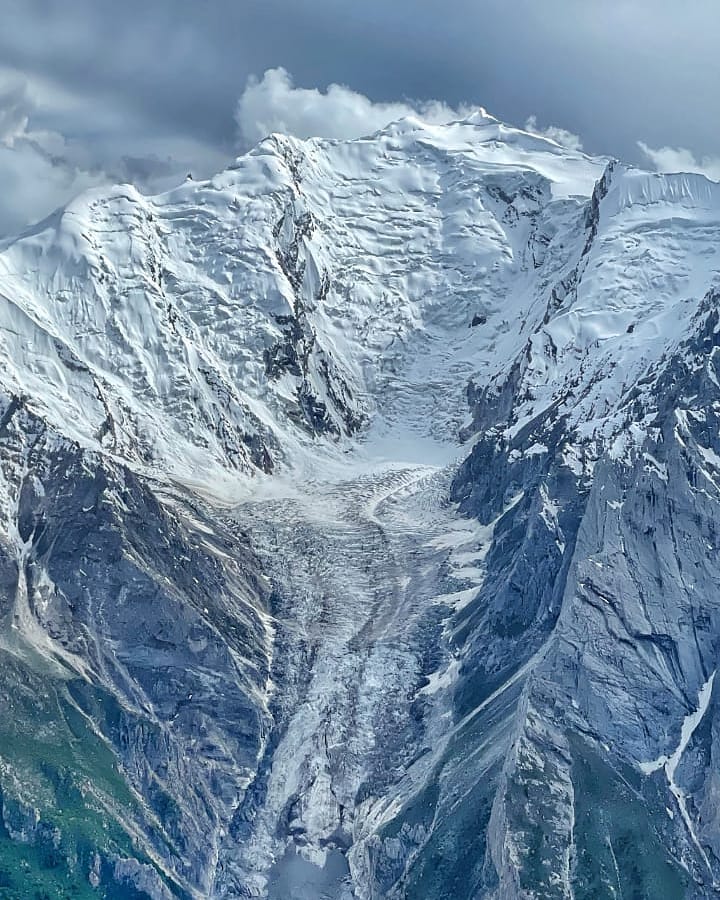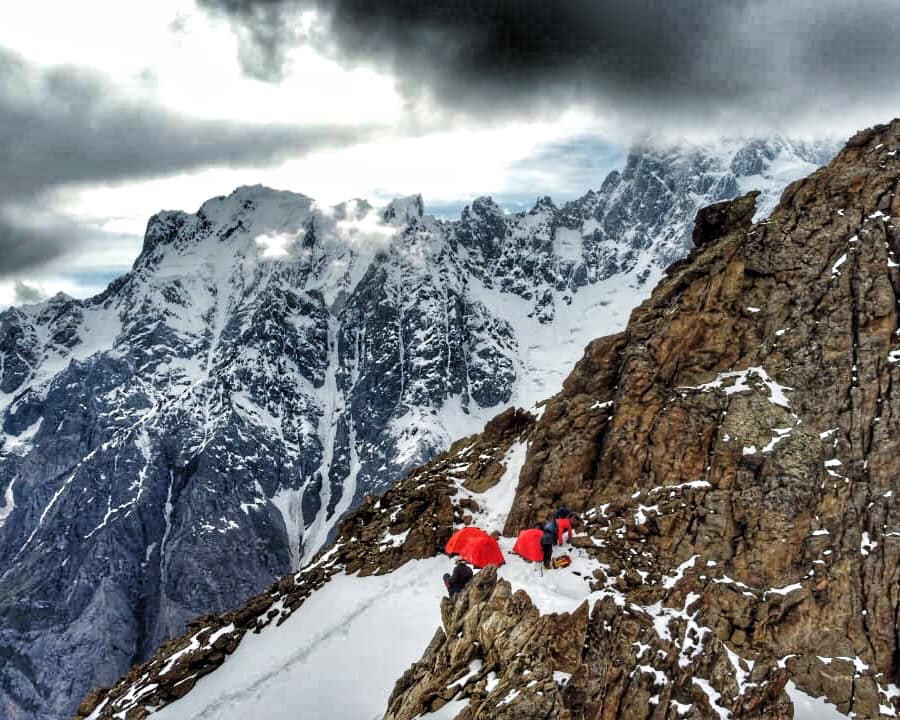Muchu Chhish is an imposing mountain located in the Batura Muztagh sub-range of the Karakoram in Hunza Valley, in northern areas of Pakistan. It is one of the tallest mountains on Earth that remains unclimbed, and the tallest one of all that is not off-limits due to religious or political prohibitions. The peak has a modest prominence, rising only 263m above the nearest col or pass.
The Batura Glacier, one of the longest outside the polar regions, flanks Muchu Chhish to the north. Muchu Chhish lacks any well-defined northern or southern ridges of its own and is nearly impassable. Only a handful of attempts have been made to reach the summit, and none have succeeded. The allure of conquering this untamed peak has attracted climbers from around the world, and expeditions are still ongoing.
Challenges of Climbing Muchu Chhish:

Muchu Chhish poses significant technical difficulties and dangers to climbers due to its steep slopes, glacial icefalls, and extreme weather conditions. The mountain involves very steep snow traverses, several ice pitches, and mixed terrain, and is unrelentingly steep up to the summit ridge. The peak lacks any well-defined northern or southern ridges of its own and is nearly impassable. The Batura Glacier, one of the longest outside the polar regions, flanks Muchu Chhish to the north, and the Batura Wall to the south, a 40km long wall topped with a ridge of ice. The mountain’s remote location and objective difficulties make it a challenging climb, and only a handful of attempts have been made to reach the summit, and none have succeeded. Climbers face unpredictable weather conditions, including heavy snowfall, high winds, and extreme cold, which can make the ascent even more challenging and dangerous.
There have been several failed attempts to climb Muchu Chhish, the highest unclimbed peak in Pakistan and the second-highest on Earth. The mountain’s remoteness, objective difficulties, and unpredictable weather conditions have made it a challenging climb. The British expedition in 2014 was forced to retreat at 6,000m, and a Spanish expedition in 1999 also failed. The Czechs have made three attempts, reaching an altitude of 6,300m in 2020, 6,600m in 2021, and 7,200m in 2022, but were forced to abandon their summit attempt due to difficult terrain. The challenges faced by these expeditions include steep snow traverses, several ice pitches, mixed terrain, and unpredictable weather conditions. The failed attempts to conquer Muchu Chhish highlight the dangers and difficulties of high-altitude mountaineering and the importance of careful planning and preparation.
The motivations of climbers attempting Muchu Chhish are multifaceted, encompassing personal challenge, the pursuit of adventure, and the scientific value of studying such a pristine environment. The mountain’s unclimbed status, steep terrain, and remote location present a significant personal challenge to mountaineers, attracting those seeking to push the boundaries of their abilities. Additionally, the pursuit of adventure drives climbers to explore and attempt to conquer uncharted and formidable peaks like Muchu Chhish. Furthermore, the scientific value of studying the pristine environment of the mountain and its surrounding region serves as a motivation for expeditions, as these areas can provide valuable insights into geology, glaciology, and climate change4. The allure of Muchu Chhish lies not only in the physical and mental challenges it presents but also in the opportunity to explore and contribute to our understanding of this untamed and unexplored terrain.

When mountaineering in remote regions, ethical considerations are paramount, encompassing respect for the local environment, communities, and cultures. Climbers are encouraged to adhere to accepted ethics, such as environmental responsibility, risk management, and respect for local customs and traditions. This includes showing consideration for the local people and their culture, respecting holy mountains and sacred places, and abiding by local climbing ethics and styles24. Additionally, climbers should strive to widen access to mountain regions unfettered by political considerations and be mindful of the ecological sensitivity of certain areas. Ultimately, the ethical considerations of mountaineering in remote regions revolve around being responsible guests, preserving the natural and cultural heritage of the areas visited, and ensuring that the impact on local communities and the environment is kept to a minimum.
The Future of Muchu Chhish:

Despite several attempts, Muchu Chhish remains unclimbed, and the challenges of the mountain continue to attract mountaineers from around the world. Future attempts to climb the peak will likely involve advancements in climbing technology, such as improved gear, equipment, and techniques, which could make the ascent safer and more feasible. Additionally, the use of drones and other remote sensing technologies could aid in route finding and assessing the mountain’s conditions, reducing the risks associated with climbing in such a remote and unpredictable environment. However, it is important to note that any advancements in climbing technology must be balanced with ethical considerations, such as preserving the natural and cultural heritage of the areas visited and minimizing the impact on local communities and the environment. As such, future attempts to climb Muchu Chhish will require careful planning, preparation, and respect for the mountain and its surroundings.
The ongoing debate about preserving untouched peaks and balancing the quest for exploration with environmental responsibility is a complex issue that requires a careful balance between the pursuit of adventure and the ethical considerations of environmental responsibility. Scientists have the responsibility of focusing the debate, emphasizing the need for better land and resource management, while mountaineers are encouraged to adhere to accepted ethics, such as environmental responsibility, risk management, and respect for local customs and traditions. Advancements in climbing technology, such as the use of drones and remote sensing technologies, could potentially minimize the impact of climbing on untouched peaks, but it is essential to ensure that these advancements are used in a manner that aligns with ethical considerations and environmental sustainability. Ultimately, the debate calls for a collaborative and informed approach that integrates scientific knowledge, conservation efforts, and ethical principles to ensure the protection of pristine environments while allowing for responsible and sustainable exploration.

As Muchu Chhish remains unclimbed, the allure of untamed mountains continues to attract mountaineers from around the world. The ongoing debate about preserving untouched peaks and balancing the quest for exploration with environmental responsibility highlights the need for a collaborative and informed approach that integrates scientific knowledge, conservation efforts, and ethical principles. As advancements in climbing technology continue to emerge, it is essential to ensure that these advancements are used in a manner that aligns with ethical considerations and environmental sustainability. The future of Muchu Chhish and other unclimbed peaks remains uncertain, but the spirit of exploration and the progress of human ambition will undoubtedly continue to drive mountaineers to push the boundaries of their abilities and explore the unknown. What will be the next unclimbed peak to be conquered, and how will mountaineers balance the pursuit of adventure with environmental responsibility in the years to come?

